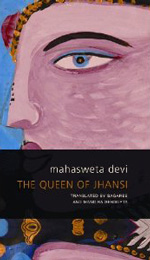

Seagull Books, hardcover, 9781906497538
Up until independence was won in 1947, India was known as the jewel in Britain's imperial crown. From the early 1600s when traders from the East India Company first established trading posts on the Indian mainland, British influence and control rapidly expanded across the country through a massive trade network and substantial territorial gains. By the mid 1800s, the East India Company was the de facto colonial government of India.
In 1857 this colonial control was threatened by a rebellion that started among the sepoys, Muslim and Hindu soldiers serving in the armies of the East India Company, but rapidly spread to the civilian population in central India. This was a bloody conflict between the Company and the Indians with atrocities and massacres committed by both sides. Few of the participants emerged from the mess with any honour.
One who fought with bravery and principle was Rani Lakshmi Bai, the young widowed Queen of Jhansi, the subject of Mahasweta Devi's 1956 book, now published outside of India for the first time.
Lakshmi Bai was just fourteen when she married the Raja of Jhansi. She lost her only child when she was 23 years old and two years later the princely state of Jhansi was annexed by the British after her husband's death. Devi lavishly describes the Queen's beauty and accomplishments, and tells us that she was celebrated for her kindness and generosity even when she was left penniless by the British takeover of her domain.
Devi also tells us that during the rebellion the Queen of Jhansi's qualities really came to the fore. She showed herself to be a skilled military strategist displaying the courage that often failed her male counterparts. Her followers loved her and she led them into battle against the British, putting to good use the sword skills that she had learned as a hobby during happier times. Sadly, in 1858 the Queen was killed on the battlefield while dressed in warrior's clothes trying to defend one of her womenfolk from attack. After her death one of her fiercest enemies, Sir Hugh Rose of the East India Company Army, said: 'Although a lady, she was the bravest and best military leader of the rebels. A man among mutineers'.
In the preface Mahasweta Devi explains that she wrote this book to reclaim the Queen of Jhansi from the mists of history, a history dominated by stories told from the British point of view. Gathering primary sources was difficult, especially as many original documents were destroyed by the British once the rebellion had been quashed, so Devi relied on oral history and local tales and songs to build a picture of the Queen's character and her involvement in the conflict. These sources give Devi's writing an intimacy, as if she herself is telling you a story out loud, waxing lyrical about the Queen's virtues. The chronology of the tale sometimes jumps around as if Devi as a narrator has just remembered an important event from earlier that she's forgotten to tell us, which adds to the impression of story-telling.
The lack of references for much of the information provided and Devi's habit of articulating the Queen's thoughts as if
the Queen herself expressed these words does frustrate the historian in me. But don't let you put that off this book.
There are many histories of the Indian rebellion written by white men about the white men involved; we need writers like
Mahasweta Devi to tell us about the same history from the other perspectives.
